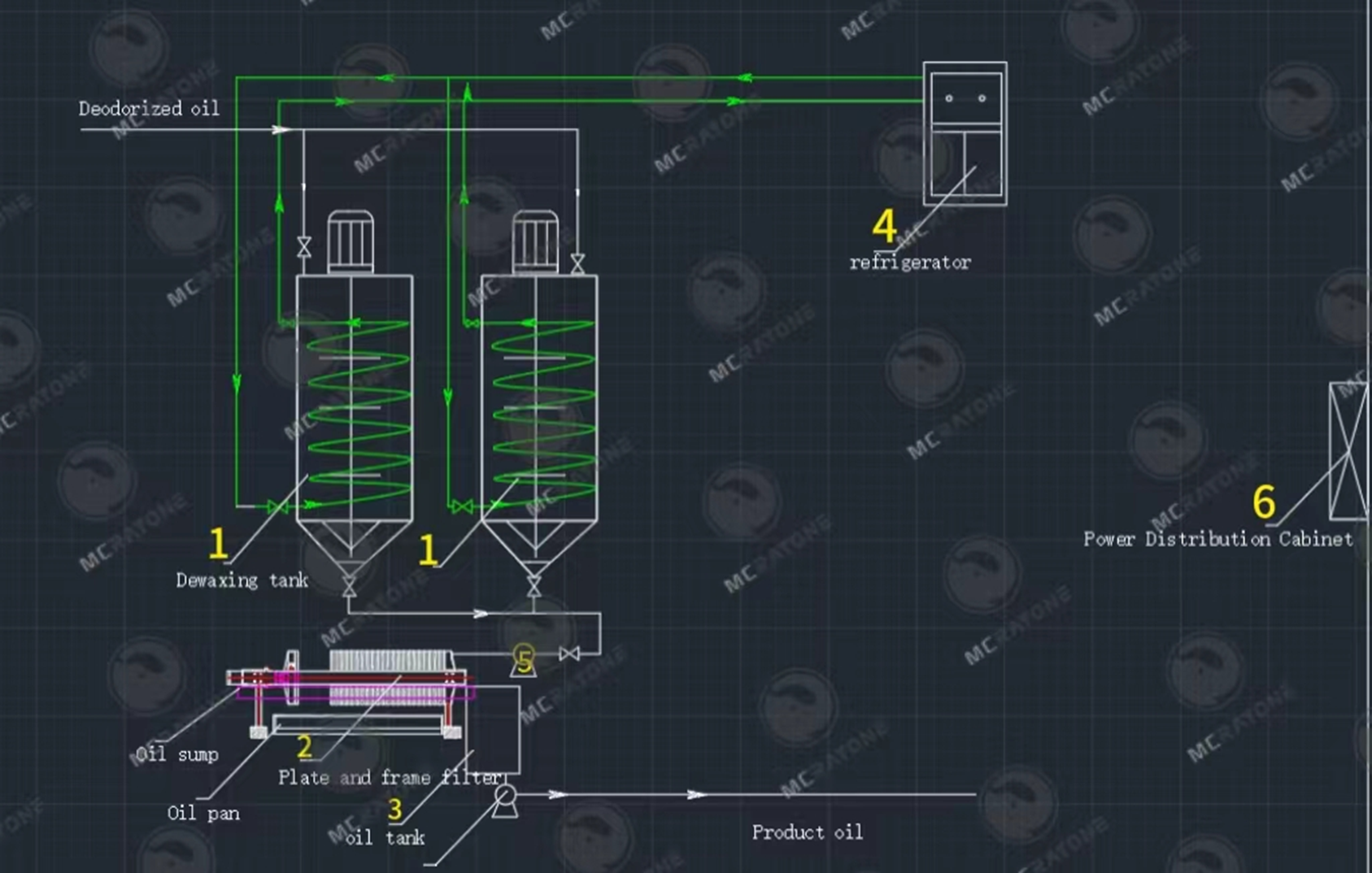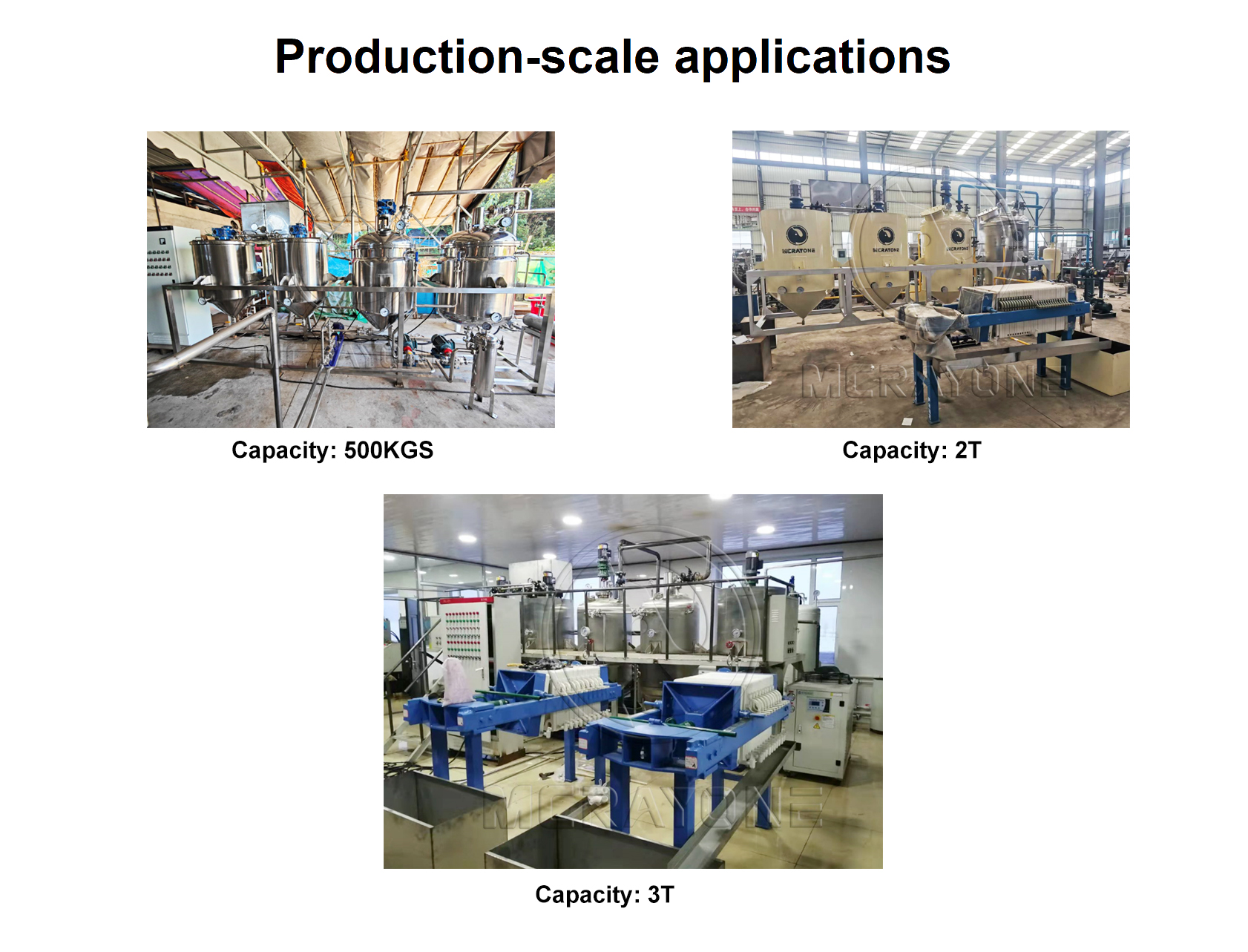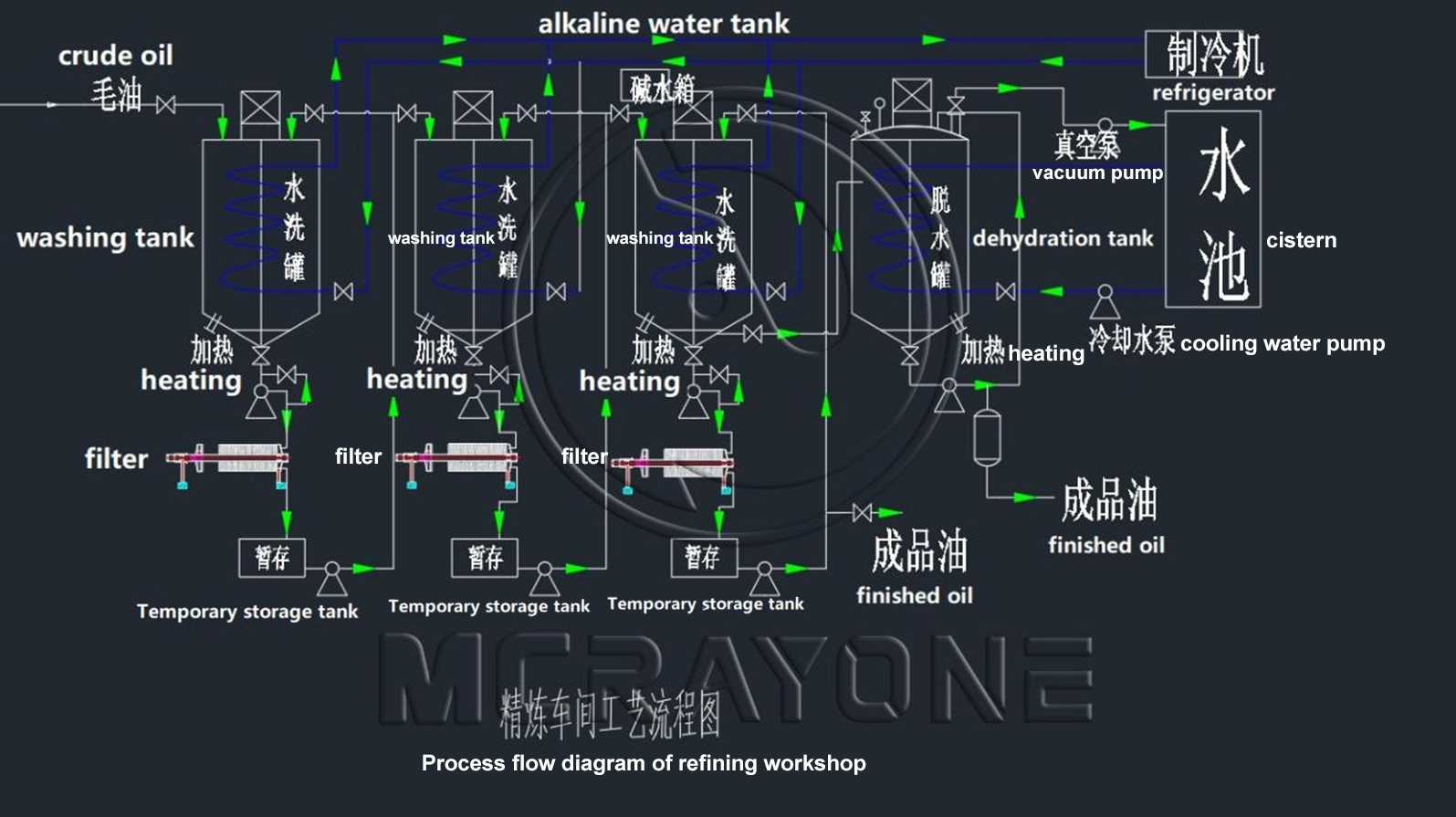Why do we need to do dewaxing?
Answer: After degumming, deacidification, decolorization, deodorization and other refining processes, sunflower oil, corn germ oil, rice bran oil and other oils with high wax content will still have a small amount of solid fat precipitated in the form of flocculents in the winter when the temperature is low, affecting the appearance and use of the oil. In addition, a small amount of wax in the oil can increase the cloud point, reduce the transparency and digestibility of the oil, and make the taste and palatability worse, thereby reducing the edible quality, nutritional value and industrial use value of the oil. On the other hand, wax is an important industrial raw material that can be used to make wax paper, waterproofing agents, gloss agents, etc. Therefore, removing or extracting wax from the oil can achieve the purpose of improving the quality of edible oils and comprehensive utilization of plant oil wax sources.
Process Flow
Sunflower oil→ heating→ heat exchange→ cooling→ crystallization→ crystal growth→ filtering→ heat exchange→ dewaxed oil

Description of the Process
Since sunflower oil is generally stored in large tanks before dewaxing, the oil temperature basically does not exceed 30°C, and the melting point of wax in sunflower oil is 79-81°C, so some wax has been precipitated in the oil. If this oil is directly used for crystallization and crystal growth, it will affect the wax precipitation and crystallization effect in the whole process, so the oil that has precipitated wax must be heated at the beginning to make all the wax dissolve in the oil.
The heated oil first uses a plate heat exchanger to exchange heat with the dewaxed oil, and then cools it to a certain temperature with frozen brine and enters the crystallization tank.
The oil cooled to a certain temperature is further cooled in the crystallization tank at a certain cooling rate. In this process, in order to ensure that the collision between the precipitated wax molecules is increased, and the waxy oil is cooled evenly, proper stirring is required. But the speed should not be too fast, otherwise it will break the crystallized particles, which is not conducive to crystallization.
After continuous cooling and crystallization of waxy sunflower oil to a certain temperature, stop stirring and keep it for a long time, so that the uncrystallized wax can continue to crystallize and precipitate, and the small crystal grains can continue to grow, that is, crystal growth.
The crystallized waxy oil flows by itself or is pumped into a heat-unloading winterization filter for filtration. During the process of crystallization and growth of sunflower oil, most of the waxes are precipitated, accompanied by more solid fats, and the precipitates generally account for 1-2% of the oil. The process fully takes this feature into consideration, and selects two large-area heat-unloading winterization filters, one for filtering and one for unloading wax, so that the production can be maintained continuously.
The filtered oil is pumped into the plate heat exchanger for heat exchange with the undewaxed oil before storage.
2TPD Dewaxing Equipment List Reference
|
NO
|
Category
|
QTY
|
Material specifications
|
|
1
|
Dewaxing tank
|
2
|
Barrel diameter: 1m
Thickness: 3mm
Material: 304 stainless steel
|
|
2
|
Stainless steel screw pump
|
1
|
Material contact part 304 stainless steel
Power: 1.5kw
|
|
3
|
Stainless steel gear pump
|
1
|
Material contact part 304 stainless steel
Power: 1.5kw
|
|
4
|
100℃ thermometer
|
2
|
Material: 304 stainless steel
100℃ temperature gauge
|
|
5
|
Motor reducer
|
2
|
Power: 1.5kw
Material: Iron
|
|
6
|
8 square plate and frame filter
|
1
|
Filter plate material: Polypropylene
Bracket material: Carbon steel
Including filter cloth, faucet
Pressure gauge 0-1.6mpa
|
|
7
|
Oil tank
|
1
|
Material 304 stainless steel
|
|
8
|
Temporary storage tank
|
1
|
Material 304 stainless steel
|
|
9
|
Refrigerator
|
1
|
Refrigeration capacity: 7510 Kcal/h
Operating power of the whole machine: 3.5kw
Water can be added above zero degrees, and antifreeze can be added below zero degrees
|
|
10
|
Pipeline, valve
|
|
Stainless steel material
|
Overall Refining and Dewaxing Process Steps:
1.Sunflower Oil Degumming
The colloidal impurities in crude oil are mainly phosphorus. The presence of colloids such as phospholipids not only reduces the quality of oil, but also promotes the transitional emulsification between oil and lye in the process of alkali refining and deacidification, increasing the difficulty of separation of saponins and aggravating the loss of neutral oil. Therefore, it should be removed first.
2.Deacidification of Sunflower Oil
Oil deacidification is mainly to remove free fatty acids in crude oil, as well as a small amount of colloid, pigment and trace metal substances in oil. Deacidification operation is one of the important factors that directly affect the oil yield and quality of oil refining. The most widely used in industrial production is the alkali refining deacidification method.

3.Sunflower Oil Decolorization
The color of the oil and some other impurities must be decolorized to meet the product quality standards. At the same time, it provides more favorable conditions for deodorization and refining. Decolorization should meet the final color index of the product; remove relevant pigments and quantitative metals; further remove trace saponins, phospholipids and other colloidal impurities and some odorous substances remaining in oil; remove polycyclic aromatic hydrocarbons and residual pesticides; reduce oil quality oxidation value.
4.Deodorization of sunflower oil
The purpose of oil deodorization is to remove odor-causing substances and other volatile substances in oil, improve the smell and color of oil, and improve the stability of oil quality. Odor peculiar to fats and oils, odors generated during decolorization, clam odors caused by oxidation of fats and oils, etc. In the deodorization stage, it is required to directly spray steam into steam distillation at high temperature in vacuum to remove these unwanted odors.
5.Dewaxing
The deodorized oil exchanges heat with the refrigerant through a plate heat exchanger. After the oil temperature drops to 22-25°C, it is pumped into a stainless steel crystallization tank. Under the action of stirring, the refrigerant is circulated in the coil to slowly cool down to 18°C to form crystals. The crystallization time is about 3h. Press the crystalline oil into the crystal growth tank, grow the crystal at a constant temperature of 18°C for 3 hours and filter to obtain the dewaxed oil.

